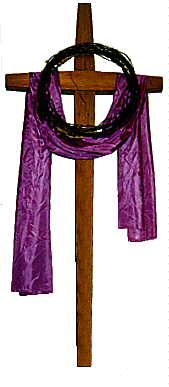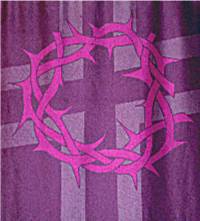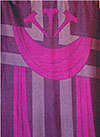|
Click here to
 |
The Season of Lent
Dennis Bratcher
 Lent
Lent
 Carnival/Mardi Gras
Carnival/Mardi Gras  Ash Wednesday
Ash Wednesday  The Journey of Lent
The Journey of Lent
 Reflections on Lent
Reflections on Lent
 The
season of Lent has not been well observed in much of evangelical
Christianity, largely because it was associated with "high church"
liturgical worship that some churches were eager to reject. However, much of
the background of evangelical Christianity, for example the heritage of John
Wesley, was very "high church." Many of the churches that had originally
rejected more formal and deliberate liturgy are now recovering aspects of a
larger Christian tradition as a means to refocus on spirituality in a
culture that is increasingly secular. The
season of Lent has not been well observed in much of evangelical
Christianity, largely because it was associated with "high church"
liturgical worship that some churches were eager to reject. However, much of
the background of evangelical Christianity, for example the heritage of John
Wesley, was very "high church." Many of the churches that had originally
rejected more formal and deliberate liturgy are now recovering aspects of a
larger Christian tradition as a means to refocus on spirituality in a
culture that is increasingly secular.
Originating in the fourth century of the church, the season of
Lent spans 40 weekdays beginning on Ash
Wednesday and climaxing during Holy Week
with Holy Thursday (Maundy Thursday), Good Friday, and concluding Saturday
before Easter. Originally, Lent was the time of preparation for those who
were to be baptized, a time of concentrated study and prayer before their
baptism at the Easter Vigil, the celebration of the Resurrection of the Lord
early on Easter Sunday. But since these new members were to be received into
a living community of Faith, the entire community was called to preparation.
Also, this was the time when those who had been separated from the Church
would prepare to rejoin the community.
Today, Lent is marked by a time of prayer and preparation to celebrate
Easter. Since Sundays celebrate the resurrection of Jesus, the six Sundays
that occur during Lent are not counted as part of the 40 days of Lent, and
are referred to as the Sundays
in
Lent. The number 40 is connected with many biblical events, but especially
with the forty days Jesus spent in the wilderness preparing for His ministry
by facing the temptations that could lead him to abandon his mission and
calling. Christians today use this period of time for introspection, self
examination, and repentance. This season of the year is equal only to
the Season of Advent in importance in the Christian year, and is part of
the second major grouping of Christian festivals and sacred time that
includes Holy Week,
Easter, and Pentecost.
Lent has traditionally been marked by penitential prayer, fasting, and
almsgiving. Some churches today still observe a rigid schedule of fasting on
certain days during Lent, especially the giving up of meat, alcohol, sweets,
and other types of food. Other traditions do not place as great an emphasis
on fasting, but focus on charitable deeds, especially helping those in
physical need with food and clothing, or simply the giving of money to
charities. Most Christian churches that observe Lent at all focus on it as a
time of prayer, especially penance, repenting for failures and sin as a way
to focus on the need for God’s grace. It is really a preparation to
celebrate God’s marvelous redemption at Easter, and the resurrected life
that we live, and hope for, as Christians.
Carnival,
which comes from a Latin phrase meaning "removal of meat," is the three day
period preceding the beginning of Lent, the Sunday, Monday, and Tuesday
immediately before Ash Wednesday, which
is the first day of the Lenten Season (some traditions count Carnival
as the entire period of time between Epiphany and Ash Wednesday). The three
days before Ash Wednesday are also known as
Shrovetide ("shrove" is an Old English word meaning "to repent").
The Tuesday just before Ash Wednesday is called
Shrove Tuesday, or is more popularly
known by the French term Mardi Gras,
meaning "Fat Tuesday," contrasting to the fasting during Lent. The entire
three day period has now come to be known in many areas as Mardi Gras.
Carnival or Mardi Gras is usually a period of celebration, originally
a festival before the fasting during the season of Lent. Now it is
celebrated in many places with parades, costumes, dancing, and music.
Many Christians’ discomfort with Lent originates with a distaste for
Mardi Gras. In some cultures, especially the Portuguese culture of
Brazil, the French culture of Louisiana, and some of the Caribbean
cultures such as Trinidad, it has tended to take on the excesses of wild
and drunken revelry. There has been some attempt in recent years to
change this aspect of the season, such as using Brazilian Carnival
parades to focus on national and cultural history. Many churches now
observe Mardi Gras with a church pancake breakfast or other church meal,
eating together as a community before the symbolic fasting of Lent
begins.
Ash Wednesday
Ash Wednesday, the seventh Wednesday before Easter Sunday, is
the first day of the Season of Lent. Its name comes from the ancient
practice of placing ashes on worshippers’ heads or foreheads as a sign
of humility before God, a symbol of mourning and sorrow at the death
that sin brings into the world. It not only prefigures the mourning at
the death of Jesus, but also places the worshipper in a position to
realize the consequences of sin. (See
Reflections on Ash Wednesday). Ash Wednesday is
a somber day of reflection on what needs to change in our lives if we
are to be fully Christian.
In the early church, ashes were not offered to everyone but were only
used to mark the forehead of worshippers who had made public confession
of sin and sought to be restored to the fellowship of the community at
the Easter celebration. However, over the years others began to show
their humility and identification with the penitents by asking that
they, too, be marked as sinners. Finally, the imposition of ashes was
extended to the whole congregation in services similar to those that are
now observed in many Christian churches on Ash Wednesday. Ashes became
symbolic of that attitude of penitence reflected in the Lord’s prayer:
“forgive us our sins, for we ourselves forgive everyone indebted to us”
(Luke 11:4, NRSV).
 Colors
and Symbols of Lent Colors
and Symbols of Lent
The color used in the sanctuary for most of Lent is purple,
red violet, or dark
violet (see Colors of the Church Year). These colors symbolize both the pain and suffering leading up to the
crucifixion of Jesus as well as the suffering of humanity and the world
under sin. But purple is also the color of royalty, and so anticipates
through the suffering and death of Jesus the coming resurrection and hope of
newness that will be celebrated in the Resurrection on Easter Sunday.
Some church traditions use grey for Ash Wednesday or for the entire season of
Lent, or for special days of fasting and prayer. Gray is the color of
ashes, and therefore a biblical symbol of mourning and repentance. The
decorations for the sanctuary during Lent should reflect this mood of
penitence and reflection. Some Anglican churches use unbleached
muslin, which can range from white to beige, with accents in red or
black for Lent to symbolize this same spirit of penitence. Some churches avoid the use of any
flowers in the sanctuary during Lent, using various dried arrangements.
This can be especially effective if a
flowering cross is used for
Easter. Other churches use arrangements of rocks or symbols associated
with the Gospel readings for the six Sundays in Lent (see
The Symbols of Lent).
In Roman Catholic and Anglican traditions, as well as some Protestant
traditions, the fourth Sunday of Lent is known as Laetere Sunday (lay-TAH-ray,
a Latin imperative meaning "rejoice!"). In the midst of the more
somber tone of penitence during Lent, this Sunday anticipates the
resurrection of Jesus, a day of hope in light of the coming Easter
Sunday. As such, it parallels the third Sunday of Advent, Gaudete
Sunday (gow-DAY-tey), with the theme of celebration for the
immanent work of God in the world. In traditions that observe Laetere
Sunday, Rose is used as a sanctuary color for that Sunday, a lightening
of the purple of Advent with the white of celebration.
Some church traditions change the sanctuary colors to red for
Maundy Thursday, a symbol of the disciples and through them the
community of the church. Since Eucharist or communion is often
observed on Maundy Thursday in the context of Passover, the emphasis is on
the gathered community in the presence of Jesus the Christ.
Traditionally, the sanctuary colors of
Good Friday and Holy Saturday are black, the only days of the Church
Year that black is used. It symbolizes the darkness brought into the
world by sin. It also symbolizes death, not only the death of Jesus but
the death of the whole world under the burden of sin. In this sense, it
also represents the hopelessness and the endings that come as human
beings try to make their own way in the world without God (see
The Days of Holy Week). Black is always replaced by white before
sunrise of Easter Sunday.
There are many ways for a congregation to mark the journey of Lent.
Of course, beginning with a service of worship for Ash Wednesday is always
appropriate (see Ash Wednesday: A Service of
Worship). During Lent, one of the most effective visual reminders
of the season that can be expanded in many variations is to
use a rough wooden cross as a focal point in the sanctuary. The type of
cross and how it is constructed will depend on exactly how it will be used.
The cross is usually erected in the Sanctuary on Ash Wednesday as a visible
symbol of the beginning of Lent. It is usually draped in black on Good
Friday. The same cross can also become a part of the congregation's
Easter celebration as it is then draped in white or gold, or covered with
flowers (see The Flowering Cross).
Responsive readings associated with various symbols of Lent placed on the
cross each Sunday in Lent can provide a structure for penitential prayers
during this season (see
The Symbols of Lent).
Another effective way to make use of the cross is to use it as a Prayer Cross
during Lent. A hammer, square nails, and small pieces of paper
are made available near the cross. At a designated time of prayer
during the Sundays in Lent, or beginning with Ash Wednesday, people are invited to write their prayer
requests on the paper, and then nail them to the cross. The quiet time
of prayer with only the sounds of the hammer striking the nails can be a
moving time for reflection on the meaning of Lent, and a powerful call to
prayer. The prayer requests can be removed and burned as part of a
Tenebrae
or Stations of the Cross service during
Holy Week to symbolize releasing the
needs to God.
Some churches have a special time of prayer or meditation one night
of each week during Lent. Often Catholic and high church
traditions pray the Stations of the Cross (see
The Fourteen Stations of the Cross). Some Protestant churches
have a special series of weekly Bible studies followed by a time of meditation
and prayer. Often, in both Catholic and Protestant traditions, the
prayer time is followed by a simple meal of soup and bread to symbolize
the penitence of the Season.
We enjoy celebrating Palm Sunday.
The children get to make paper palm branches and for many it is one of the few
times they get to take an active role in "big church." We wave the
palm branches and celebrate. And we all love Easter Sunday! It is a
happy time, with flowers, new clothes, and the expectation of Spring in the
air.
Yet there is
something significant missing if we only concentrate on celebration for these
two Sundays. It is too easy and promotes much too cheap a grace to
focus only on the high points of Palm Sunday and Easter without walking
with Jesus through the gathering shadows of Maundy Thursday and the
darkness of Good Friday. For us, that journey begins on Ash Wednesday,
the beginning of Lent. Lent is a way to recall a larger story than just
celebration. It is a way to face the reality of the consequences of sin
and the terrible toll it takes on the world. Lent calls us to examine
our own lives with the prayer, “Search me, O God, and know my heart;
test me and know my thoughts. See if there is any wicked way in me (Psa
139:23-24).
The journey through
Lent is a way to places ourselves before God humbled, bringing in our
hands no price whereby we can ourselves purchase our salvation. It is a
way to confess our total inadequacy before God, to strip ourselves bare
of all pretenses to righteousness, to come before God in dust and ashes.
It is a way to empty ourselves of our false pride, of our
rationalizations that prevent us from seeing ourselves as needy
creatures, of our external piety that blinds us to the beam in our own
eyes.
Through prayer that gives up self, we seek to open ourselves up before
God, and to hear anew the call "Come unto me!" We seek to recognize and
respond afresh to God’s presence in our lives and in our world. We seek to
place our needs, our fears, our failures, our hopes, our very lives in God’s
hands, again. And we seek by abandoning ourselves in Jesus’ death to
recognize again who God is, to allow His transforming grace to work in us
once more, and to come to worship Him on Easter Sunday with a fresh victory
and hope that goes beyond the new clothes, the Spring flowers, the happy
music.
Yet, that celebration begins in ashes. And it journeys though darkness. It is a spiritual pilgrimage
that I am convinced we must all make, one way or the other, for genuine
spiritual renewal to come.
I have heard the
passage in 2 Chronicles 7:14 quoted a lot: ". . .if my people who are
called by my name humble themselves, and pray and seek my face, and turn
from their wicked ways, then I will hear from heaven, and will forgive
their sin and heal their land." This usually is quoted in the context of
wanting revival or renewal in the church. The prayer is usually
interpreted as intercessory prayer for others, since we too easily
assume that any problem lies with someone else. Yet a careful reading of
the passage will reveal that the prayer that is called for here is not
intercessory prayer for others; it is penitential prayer for the
faith community, for us. It is not to call for others to repent;
it is a call for us, God’s people, to repent. It is our
land that needs healed, it is our wicked ways from which we need
to turn, we are the ones who need to seek God’s face.
Perhaps during the Lenten season we should stop praying for others as if
we were virtuous enough to do so. Perhaps we should take off our righteous
robes just long enough during these 40 days to put ashes on our own heads, to
come before God with a new humility that is willing to confess, "Lord, be
merciful to me, a sinner." Maybe we should be willing to prostrate ourselves
before God and plead, "Lord, in my hand no price I bring; simply to the
cross I cling." That might put us in a position to hear God in ways that we
have not heard Him in a long time. And it may be the beginning of that healing
for which we have so longed.
O Lord, begin with me. Here. Now.
-Dennis Bratcher, Copyright ©
2018, Dennis
Bratcher - All Rights Reserved
See Copyright and User Information Notice |

Related pages
The Symbols of Lent
The Church Year
The Lectionary
The Days of Holy Week
Daily Readings for Lent
Reflections on Ash Wednesday
Daily Readings for Holy Week
The Easter Season
Lectionary Commentary:
Year A
Year B
Year C
A
service of worship that focuses on the theme of remembering as a setting for
Eucharist: Remember!
Communion for Lent
A Service of Worship for
Ash Wednesday
An
adaptation of Passover for use in a Christian service of worship on Maundy
Thursday: Introduction to a Christian Seder and
A Christian Seder Haggadah.
The Cross as A
Journey: Stations of the Cross for Protestant Worship |

